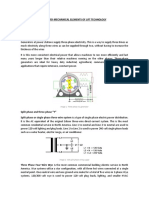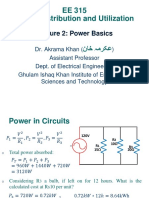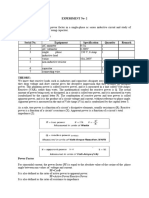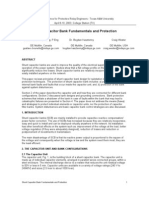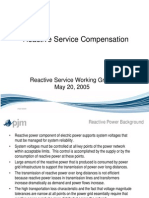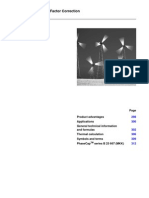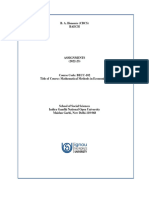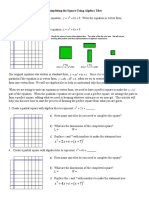Power Factor
and
Reactive Power
Ward Jewell
Wichita State University
Power Systems Engineering Research Center
(pserc.org)
PSERC
Energy to lift a 5 pound weight
2 feet high:
2 ft x 5 lb = 10 ft-lb
= 0.0000038 kWh
= 0.0033 “calories”
(which are actually kcal)
Value at 10.3 cents per kWh:
(average residential US price, summer 2006)
0.000039 cents
PSERC
Page 1
� As dragline bucket lowers, motors
generate, return electricity to source
PSERC
Induction motor with no load
800
735.249
600
energy
to motor
power (watts)
400
200
p ( t)
0
0 energy
200
400
from
− 465.196
600
0 0.002 0.004 0.006 0.008 0.01 0.012 0.014 0.016 0.018
motor
0 t 0.017
time (seconds)
PSERC
Page 2
� Induction motor
800
735.249
600
power (watts)
400
average
p ( t)
200
power:
0
200
130 watts
400
− 465.196
600
0 0.002 0.004 0.006 0.008 0.01 0.012 0.014 0.016 0.018
0 t 0.017
time (seconds)
PSERC
Incandescent lights
350
306.8
300
power (watts)
250
200
average
p ( t)
150 power:
100
150 watts
50
0
0
0 0.002 0.004 0.006 0.008 0.01 0.012 0.014 0.016 0.018 0
0 t 0.017
time (seconds)
PSERC
Page 3
� Incandescent Lights
PSERC
Induction motor with no load
PSERC
Page 4
� Lights and Motor
Power Current Voltage
Incandescent 0.15 kW 1.3 A 118.0 V
lights
Induction 0.13 kW 5.1 A 117.7 V
motor with
no load
PSERC
Why do the Volts and Amps matter?
PSERC
Page 5
� Motors and Resistance Heat:
100 MW
Customer voltage Power lost in wires
Resistance Heat 12.3 kV 1.0 MW
Motors 11.7 kV 2.3 MW
PSERC
Incandescent Lights
PSERC
Page 6
� Incandescent lights power:
Power = 118 V x 1.3 A
= 153 W
= 0.15 kW
= power measured by meter
PSERC
Incandescent Lights
PSERC
Page 7
� Induction motor with no load
PSERC
Induction motor power:
117.7 V x 5.1 A
= 600 W?
= 0.6 kW?
NOT the power measured by meter
PSERC
Page 8
� Induction motor with no load
PSERC
Define some new values:
Apparent power = volts x amps
For the motor:
117.7 V x 5.1 A
= 600 VA
= 0.6 kVA
VA: volt-ampere
PSERC
Page 9
� Define some new values:
Power Factor =
Average (“real”) (kW) power
Apparent (kVA) power
For the motor:
pf = 0.13 kW / 0.60 kVA
pf = 0.22
PSERC
Define some new values:
reactive power = 0.58 kVAR
kVA
the power triangle
for the motor:
0.60=
reactive power =
ower
VI2 – average power2
rent p
2 2
( 0.60kVA) − ( 0.13kW) = 0.59 kVAR
Appa
0.58 kVAR
VAR: volt-ampere reactive
real power = 0.13 kW
PSERC
Page 10
� Induction motor with no load
PSERC
Lights and Motor
Real Reactive Apparent Power Current Voltage
Power power power factor
Incan- 0.15 0 kVAR 0.15 kVA 1.0 1.3 A 118.0 V
descent kW
lights
Induction 0.13 0.58 0.60 kVA 0.22 5.1 A 117.7 V
motor with kW kVAR
no load
Note: the motor’s reactive power will stay near its
no-load value of 0.58 kVAR as its load and real
power (and thus apparent power and power
factor) vary from no load to full load.
PSERC
Page 11
� Power factor and reactive power
are indicators of
power losses in wires
voltage drop between supply and load
PSERC
Typical Power Factors
Induction motor 0.7-0.8
Resistance heat 1.0
Incandescent lights 1.0
Fluorescent lights 0.6-1.0
Battery Chargers 0.6-1.0
Computers 0.5-1.0
Variable Speed Motor Drives 0.5-1.0
PSERC
Page 12
� Power factor:
lagging or leading?
Most loads with lower power factor
are inductive.
Current lags voltage.
Power factor is “lagging.”
PSERC
Induction motor with no load
voltage current
3.6 ms
Current lags voltage by about 3.6 milliseconds
PSERC
Page 13
� Another way to calculate power factor
16.7 ms
3.6 ms
One 60 Hz cycle = 1/60 seconds = 16.7 ms
PSERC
Another way to calculate power factor:
“displacement” power factor
(3.6 ms / 16.7 ms) x 360 degrees = 77 degrees
current lags voltage by 77 degrees
cosine (77 degrees) = 0.22
power factor is 0.22 lagging
pf = cos θ
θ = angle between voltage and current
PSERC
Page 14
� Incandescent lights
Current and voltage are “in phase.”
PSERC
Incandescent lights:
displacement power factor:
angle between voltage and current
= 0 degrees
pf = cos(0 degrees) = 1.0
true power factor:
pf = 0.15 kW / 0.15 kVA
pf = 1.0
PSERC
Page 15
� If voltage and current are sinusoidal
displacement pf (DPF) = true pf (PF)
motor lights
PSERC
Correcting (increasing)
power factor
PSERC
Page 16
� Capacitors to improve power factor:
capacitors release energy
when inductors consume
1.2
1
Capacitor 0.5
current iL( t)
0
ic ( t)
Inductor 0.5
current 1
− 1.2
0 0.002 0.004 0.006 0.008 0.01 0.012 0.014 0.016 0.018
0 t 0.017
PSERC
Induction motor with
power factor correction capacitor
PSERC
Page 17
� Induction motor with
power factor correction capacitor
Real Reactive Apparent Power Current Voltage
power power power factor
Induction 0.13 0.58 0.60 0.22 5.1 A 117.7
motor kW kVAR kVA V
Induction 0.13 0.11 0.18 0.96 1.5 A 118.4
motor with kW kVAR kVA V
capacitors
PSERC
Wire losses:
motors with capacitors
Customer voltage Power lost in wires
Motors 11.7 kV 2.3 MW
Motors with power 12.3 kV 1.0 MW
factor correction
capacitor
PSERC
Page 18
� Incandescent lights with
power factor correction capacitor
PSERC
Incandescent lights with
power factor correction capacitor
Real Reactive Apparent Power Current Voltage
power power power factor
Incan- 0.15 0 kVAR 0.15 kVA 1.0 1.3 A 118.0 V
descent kW
lights
Lights with 0.15 0.64 0.66 kVA 0.23 5.5 A 119.9 V
capacitors kW kVAR leading
PSERC
Page 19
� Wire losses:
lights with capacitors
Customer voltage Power lost in wires
Resistance heat 12.3 kV 1.0 MW
Resistance heat 13.0 kV 2.0 MW
with power factor
correction
capacitors
PSERC
Leading power factor
Current leads voltage in a capacitor.
Too much capacitance causes low leading
power factor.
(just as bad as low lagging power factor)
Leading power factor causes high voltage
and increased wire losses.
Use the correct amount of capacitance.
(more is not better)
Switch capacitors off when motors are off
(just put capacitor on same switch as motor)
PSERC
Page 20
� If voltage and current are sinusoidal
displacement pf = true pf
motor lights
PSERC
If waveform is not sinusoidal:
PC voltage and current
PSERC
Page 21
� If waveform is not sinusoidal:
PC voltage and current
PSERC
Harmonic distortion
PSERC
Page 22
� Low power factor caused by
harmonic distortion cannot be
corrected by capacitors
Harmonic currents are not accompanied by
harmonic voltage, so average (real) power
in harmonics is almost zero.
pf = average power / apparent power
decreases
PSERC
Common harmonic loads
computers
motor drives
battery chargers
rectifiers
induction heaters
arc furnaces
To correct low power factor caused by
distorted current waveforms, the
harmonic currents must be filtered.
PSERC
Page 23
� Capacitors can make
harmonic distortion worse:
Lights with power factor correction capacitor
This is rare, but should be considered
in the presence of harmonic loads
PSERC
Summary
Induction motors and other inductive equipment load the electric
power system differently than incandescent lights and resistive
heaters
Power Factor and Reactive Power are indicators of power lost in
wires and reduced customer voltage
Low displacement power factor caused by induction motors (and
other inductive loads) can be corrected with power factor
correction capacitors
Power factor correction capacitors must be sized properly
Power factor correction capacitors cost much less than utility
power factor charges and will eliminate those charges
Power factor correction capacitors should be disconnected when
motors are disconnected
Low harmonic power factor is corrected with filters, not capacitors.
Capacitors may make it worse.
PSERC
Page 24
� Ward Jewell
316.978.6340
ward.jewell@wichita.edu
pserc.org
(slides are posted under “presentations”)
PSERC
Page 25






















